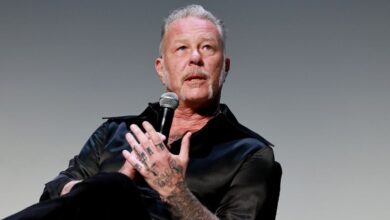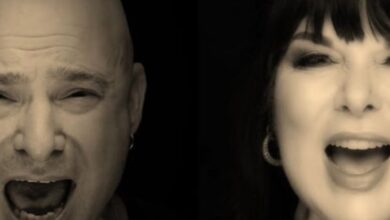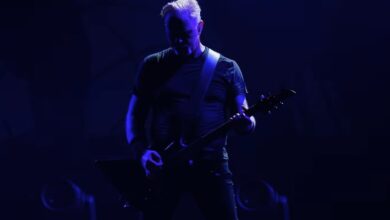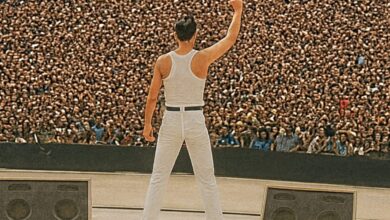Disturbed’s “Don’t Tell Me” Featuring Ann Wilson Connects Eras and Hearts
On a chilly evening in January 2024, the members of Disturbed took to the stage with a charged energy. The crowd gathered in the arena murmured in anticipation. When the opening chords of “Don’t Tell Me” rang out—first tentative, then full and confident—the audience recognized immediately that this was no ordinary performance. Something unique was in motion, a collision of rock voices and emotional truth. As the lights dimmed and the band launched in, the tension was palpable; fans leaned forward, eager to hear how the studio chemistry between Disturbed and Ann Wilson would translate live.
From the start, the interplay between David Draiman’s familiar, gravelly vocal tone and the soaring, operatic power of Ann Wilson elevated the performance. Wilson stood stage left, commanding yet gracious, stepping into the spotlight at key moments. The first time their voices crossed in harmony felt electric: Draiman’s rasp blending with Wilson’s clarity produced an unexpected harmonic tension. The balance was delicate—and for the audience, thrilling. It was as though two eras of rock collided, and both emerged richer for the encounter.
Instrumentally, the arrangement lent room for dramatic dynamics. The guitars thundered during heavier passages, and when the music softened, sparse strings and piano accents emerged, giving Wilson’s voice space to breathe. In those quieter moments, Draiman would drop back, letting Wilson carry the melody alone before rejoining with a punch. The ebb and flow kept listeners off balance in the best possible way, where predictability was replaced with fresh emotional arcs. What struck many was how the band rethought the song live rather than merely replicating the studio version.
The energy in the crowd soared as the performance progressed. Fans who had sung along to Disturbed’s heavier tracks now found themselves shouting Wilson’s name. The visuals supported the sound: soft spotlighting illuminated Wilson in her dramatic vocals, while strobing and color washes accentuated the band’s heavier moments. At one moment, Draiman reached toward Wilson in a gesture of musical kinship, as if acknowledging that this was a mutual journey across emotion and voice. That visual metaphor seized in many cameras and later circulated online.
Midway through, Ann Wilson claimed the spotlight fully during the operatic bridge. Her voice climbed into her signature register, and the room hushed in respect—except for the swelling backing vocals from the band, who echoed fragments behind her. In that stretch, silence felt sacred. When Draiman reentered, his backing vocals seemed almost like echoes, circling around Wilson’s dominant phrasing. The tension resolved in the final chorus, where both voices surged together, unrestrained.
One surprise moment came when Wilson sang a small ad lib that didn’t appear in the studio version—a gentle sustained note at the end of a line—that sent a ripple through the crowd. Draiman responded in kind, extending a note of his own in the next bar. That spontaneous flourish told the audience that this performance was alive, not rehearsed down to the bone. For longtime fans, it was a gift: to witness something new, even within a song they thought they knew.
After the final chorus crashed into a sustained crescendo, the band held the last chord for an extra beat. The crowd erupted. It wasn’t just applause, but cheers, whistles, and stamping feet. Some fans wept. Cameras flashed. The band members and Wilson exchanged proud looks, and Wilson raised her hand in acknowledgment. The moment stretched, as if everyone in the arena felt they had participated in something beyond a concert—it was a ritual of voices, resilience, and reverence.
Backstage, the musicians reportedly hugged, laughed, and expressed relief and exhilaration. Draiman, Wilson, and the touring band discussed how well the delicate transitions had worked live, and how audience reaction had validated their risk. That feedback loop—between stage and crowd—is what many artists say they live for. It was clear in interviews afterward that the performers considered this one of their most meaningful nights.
Critics and journalists scrambled to respond immediately. Some reviews praised the marriage of Wilson’s classic rock stature with Disturbed’s modern force. Others noted how the collaboration humanized Draiman’s voice and gave Wilson a fresh context. A few reviews questioned whether fans of either artist would fully accept this fusion—but the overall consensus was that the performance had transcended typical guest features. It felt like something bigger than hype, something rooted in artistic courage.
For the fan communities, social media erupted with clips and memes. Videos of Wilson’s vocal climb went viral. Some fans dissected the timing of Draiman’s cues, others praised the emotional weight. Forums filled with threads titled “best collab ever?” or “why this performance matters to rock now.” Many longtime Heart fans discovered Disturbed that night; many Disturbed fans felt newly connected to classic rock’s lineage. It was cross-pollination in action.
In later interviews, Dan Donegan of Disturbed spoke about how personal life experiences informed the song’s emotional core—and how Wilson’s presence amplified that vulnerability. He mentioned that the band had initially debated whether the collaboration would overshadow or support the song’s message; but in this performance, it felt symbiotic. For Wilson, too, joining Disturbed was an opportunity to reach new ears while affirming that powerful voice endures beyond style or era.
Subsequent performances included Wilson as a guest at select shows, but none perhaps carried the same rawness as that debut. Each time, the audience watched for new variations, new sparks of spontaneity. Still, many fans refer back to that first live moment as the gold standard. Bootleg recordings, with variable sound quality, nonetheless capture the emotion: the holler of the crowd, the crack in Wilson’s voice on a high note, the synergy of voices that surprises and delights.
As the tour progressed, setlists occasionally shifted to accommodate Wilson’s parts. Lighting cues, backing vocals, transitions—everything refined to make the performance smoother, yet always preserving moments of risk. The band understood that what made that night special was not perfection but the tension of real voices meeting real risk, unafraid of cracks or harmonic dissonance.
In broader context, this collaboration signaled something about rock’s evolution: that veteran voices and newer ones can speak across generations, not as nostalgia but as active conversation. For fans of rock, hearing Wilson stand with Draiman in full power affirmed that rock voice still commands space in a changing musical landscape. The performance was, in some sense, a statement.
When reflecting on that night months later, many described it as one of the tour highlights. In fan surveys and setlist polls, that extended version of “Don’t Tell Me” often ranks among the most desired encore tracks. And on streaming services, the studio version with Wilson also saw renewed attention—evidence that the live magic bled back into the recorded track’s life.
Ultimately, what made that evening special was not just the presence of Ann Wilson, nor just the fact it was a live rendition, but the feeling of connection: voice meeting voice, era meeting era, artist meeting audience. The performance reminded listeners of the transcendent power of music to bring contrast, reconciliation, and surprise all into one shared moment. That night, Disturbed and Ann Wilson didn’t just sing together—they made the kind of music people will remember.





